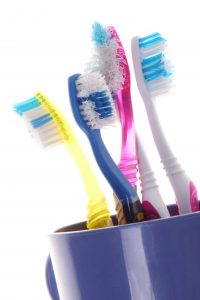 Warning: You might replace your toothbrush after reading this. Smart move!
Warning: You might replace your toothbrush after reading this. Smart move!
You use your toothbrush to clean your teeth, but have you ever considered it might not be so pristine? As it turns out, that toothbrush can have some really nasty things hiding in the bristles (that you take for granted as healthy tools of the trade for good dental hygiene).
Advertisement
Regular brushing is important for preventing plaque build-up and cavities, but the brush itself can be host to many kinds of bacteria that could be harmful. Your dentist may not have told you the whole story, so it’s time I did…
Here is an idea of just a few of the offenders you may be putting in your mouth.
RELATED READING: Alert! Coughs and sneezes spread infection faster than we think
Bathroom bacteria
The transfer of bacteria from your teeth and washed down the sink goes both ways. Our mouths have more bacteria than any other part of the body and of course we put our toothbrushes into our mouths. But our spectacular oral cavity is home to hundreds of different types of microorganisms, which can be transferred to a toothbrush during use, Dr. Maria L. Geisinger, professor of periodontology at the University of Alabama, told Science Daily.
“When we brush, those bacteria can end up on the toothbrush, along with toothpaste, blood, food debris and saliva.”
On the other hand, we keep our toothbrushes in the bathroom, because that’s where we brush our teeth. But bathrooms are full of airborne bacteria. Yes, it gets worse.
The bathroom is a warm, moist, bacteria-friendly environment. Those bacteria can include yeasts, or even fecal germs – all things we don’t want on our toothbrushes or in our mouths!
The end result is that your toothbrush can get pretty vile. “The number of microorganisms can vary wildly from undetectable to over 1 million colony-forming units (CFUs),” Geisinger said of the bacterial load on your brush. “Proper handling and care of your toothbrush is important to your overall health.”
RELATED READING: Germ alert: 95% not doing one necessary thing
Toothbrush hygiene tips
Fortunately, there are things you can do to help keep your toothbrush and your mouth clean while also protecting your oral health. The simplest thing is to rinse your toothbrush after each and every use. You shouldn’t skip this step, but the Centers for Disease Control and Prevention (CDC) advises that rinsing is simply not enough. The CDC says there are other strategies to keep your brush free of bacteria and protect your oral health:
- Never share your toothbrush. This is particularly important for people with a compromised immune system or infectious disease.
- Rinse your toothbrush after each use, then store it upright and allow it to air-dry.
- Don’t allow toothbrushes stored in the same holder to touch, as that could transfer bacteria between them.
- Replace your toothbrush regularly, either every three or four months or when the bristles look splayed or worn out.
On the flip-side, the CDC advises that it’s not necessary to use mouthwash or disinfecting solutions to clean your brushes, and putting your toothbrush in the same solution as other brushes could actually lead to contamination.
Also, while covers that enclose the toothbrush head seem like a good idea, they actually create conditions that are even friendlier for bacteria growth.
It’s smart to take precautions to keep your toothbrush clean and free of bacteria, and the next step is to find the right fluoride toothpaste to meet your oral health needs.
Advertisement
Here’s to that bright, white smile (germ-free).
